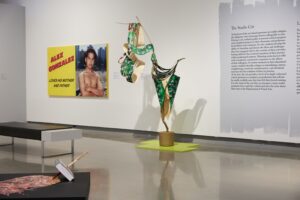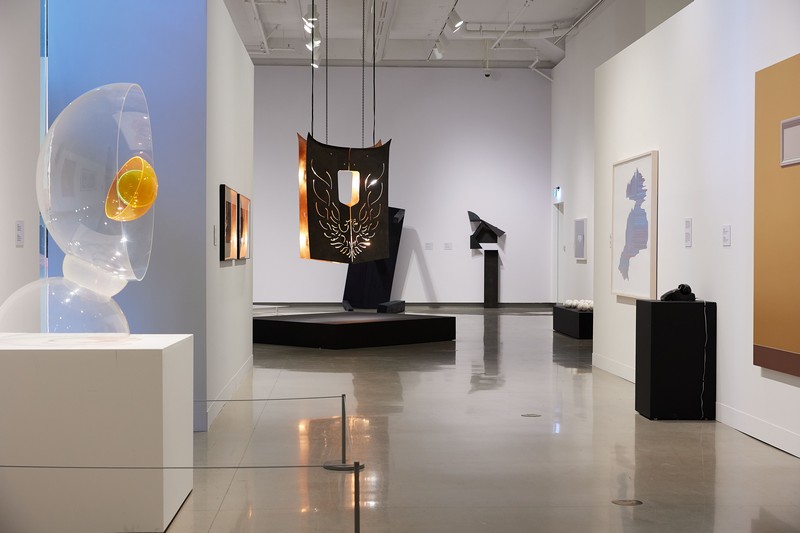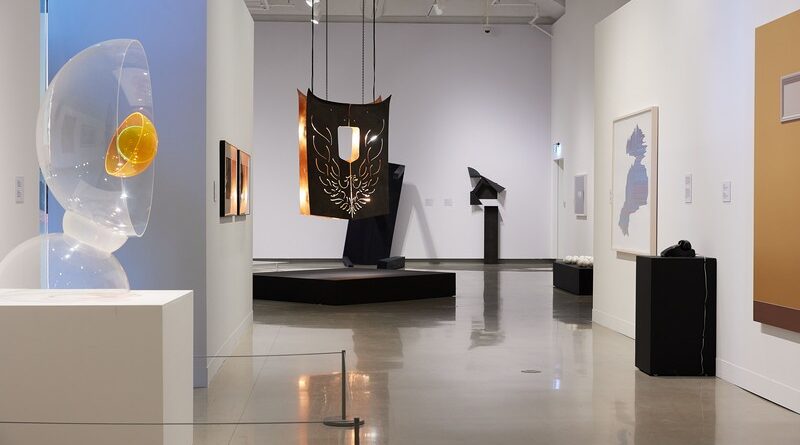Art School Confidential at the Ottawa Art Gallery
Art review
Maureen Korp
Art School Confidential, a large exhibition at the Ottawa Art Gallery, has been mounted in celebration of the University of Ottawa visual arts program, 1974 to the present, its first 50 years. The curator is Penny Cousineau-Levine. At the entry, a small screen video by Max Dean and Joel Silver presents a circle of hands clapping beautifully. The artists’ film is entitled “Cancer is our Story (overcome),” 2013.
Pause for a moment. Now walk inside.
 On the right, an assemblage of empty chairs is mounted before an empty lectern. The installation, a sculpture by Michel Goulet, is entitled “Motifs / Mobile,” 1987. Overhead on the wall, we read: “The Studio Crit.” What is—? A “crit” is the critique offered student work by the instructor. Will it be encouraging, or mortifying? Classmates—what will they say? How does one get through the day? Look around.
On the right, an assemblage of empty chairs is mounted before an empty lectern. The installation, a sculpture by Michel Goulet, is entitled “Motifs / Mobile,” 1987. Overhead on the wall, we read: “The Studio Crit.” What is—? A “crit” is the critique offered student work by the instructor. Will it be encouraging, or mortifying? Classmates—what will they say? How does one get through the day? Look around.
One answer is suggested by the large inkjet print entitled “Self-portrait, no.3,” 2008 by Chantal Gervais. The skeletal figure has its head turned away from whatever is being said.
A pile of broken bricks and old art history books litters one corner of the floor. Don’t trip. A dunce cap has been thrown on top, or is that—a Klan hood? “RESIST All Texts,” 2023-24 was created by a group of four calling themselves “A Fine Discipline.” They are Cara Tierney, Aylin Abbassi, Ash Barbu, and fin xuan.
In the spirit of “Studio Crit,” let’s look at “Art School Confidential.” Is it a fifty-years chronology of some sort?—No. Are there hidden stories to be told at last? —No. Not obviously so, anyway. Nonetheless, there is good to be found.
Happenstance may permit viewers moments of thematic connection, insight. Zainab Hussein, for example, has hung two fine blue and gold sari panels down one tall wall. In a continuing loop, key statements are projected onto the panels. They include: “But the warplanes are so damn loud,” and “Representing more than a million people can be exhausting.” This work is one of a series the artist entitles “Personal Mythologies 3 (iteration 5),” 2020.
On the neighbouring wall is a three-panel digital video projection by Rah Eleh, entitled “Blue Girl,” 2019. Sit with it a while. Note the seated woman playing a lyre, another standing under an arch amid rubble; in the sky falling flames. Eleh’s triptych is not unlike Bruegel’s medieval depictions of hell, and Hussein’s laments.
Most of the work in the exhibition is from the last 15 years. There is little work from the early days of the department. What we see of the work of Edmund Alleyn, Jacques Hurtubise, and Peter Gnass all precedes 1974. Is this all that could be found today?
The exhibition labels do not tell us if the artists being credited with each work were instructors now or then, or students, now or then. The artists’ life dates are all missing from their labels. Are artists immortal? Ask Google.
Several recent sculptures might well fit the specifics of public art sites. “Rumble,” 2017 by Michael Belmore, for example, is a large hanging copperwork with a feline face on one side, and two horned critters on the other. “Gorgone,” 2012 by Denis Rousseau is a vibrant vegetal floor sculpture of polyurethane, wood, and metal. “Kicker Chaser (Before / After / Before),” 2018 / 2023 by A.M. Dumouchel makes reference to Covid times with its use of a multitude of labels reading, “Triple Antibiotic.” The City of Ottawa public art program is 40 years old. Is there a tie-in with the city? Could there be?
The ice fields are melting. We see quiet responses in the work of Leslie Reid, “Kluane Icefields,” 2024; Amy Schissel, “Indicator,” 2020, and Julia Martin, “Uneasy, 2014. What’s to be done? Talk across waters. “Santo Spirito,” 2014 by Pierre Dorion brings together the orderly proportions of the East (kami no michi) and the West (Pythagorean) in his large oil on linen.
The socio-cultural histories of peoples the world over are drawn from the work of artists. Anishnaabe artist Ron Noganosh (1950-2017) of the Magnetawan First Nation knew his times well. “That’s all it costs,” 1991 is a wry, wickedly accurate hand drum assemblage of the imagery of colonialism, specifically that of the fur trade. In the artist’s sculpture we see the “worth” of Anishnaabe interactions with the Hudson’s Bay Company. A little white stuffed bear is attached with a Canada ribbon; two very small pigs sit on top of the construction, with a pile of coins. Tied together are drawings of deer, feather, and warrior. Below hangs a bullet-shredded American flag. The hand drum is not only marked with HBC colours, it bears an HBC tag. The oh-so-pertinent words read: “That is all it costs when you shop at The Bay.”
Displayed in another room of the exhibition, Cindy Stelmakovich’s “Anatomy of a Diamond Jubilee,” 2014 appears to be the only other work to address Canada’s colonial history.
“With words and finger pointing, slowly we make the world our own,” the poet Rilke wrote. Michael Schreier’s small photograph entitled “wound,” 2005 is of two men, one younger than the other. Theirs are the faces of hard times. Are they father and son? Could be. We see hurt through Schreier’s lens.
To date, there is no catalogue for the exhibition. May there be one soon to tell us more—both the back stories and hard data of Art School Confidential.

Photo: Rémi Thériault
Continuing exhibition
Art School Confidential
Curated by Penny Cousineau-Levine
Until September 22
Ottawa Art Gallery, 10 Daly Street
Wheelchair accessible. Free,
Tues., Wed., Sun., 10am-6pm
Thurs., Fri., Sat., 10am-9pm
